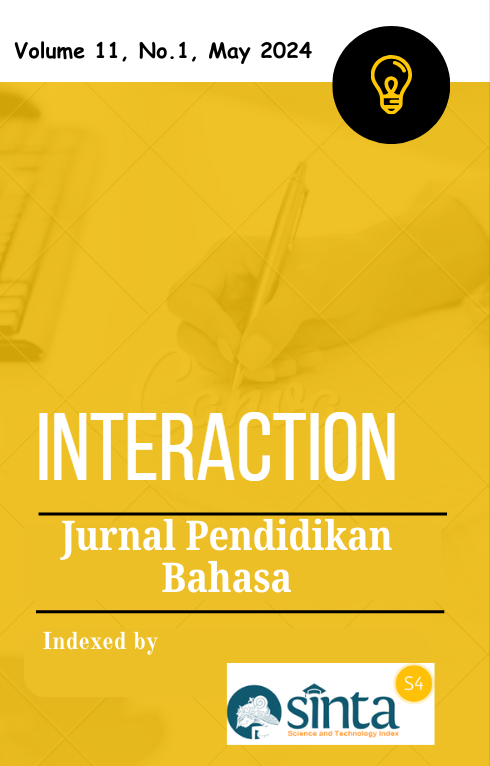Indonesian English Teacher’s Stories in Designing Differentiated Speaking Activity Instruction: A Narrative Study
Abstract
This inquiry aimed to explore and make sense of the stories of an English language teacher’s experiences using the CEFR framework to design the DI of speaking activity instruction. More specifically, the research was intended to understand the usage of CEFR in designing differentiated learning of speaking activity instruction. To achieve the purpose of the research, a narrative inquiry is employed. One English language teacher at a junior high school in Indonesia participated in this research and shared her experience using CEFR as a tool for designing differentiated learning. The data were collected through the online interview to collect information from the teacher's Zoom application and analyzed qualitatively in steps. The findings showed that in narrative research, limited attention has been paid to how English teachers constructed their differentiated teaching-speaking instruction through a CEFR framework. this narrative inquiry indicated that CEFR accommodated students’ needs and fostered students’ competencies, effectively designing differentiated teaching and speaking instruction. English teachers had different stories in constructing differentiated instruction (DI) tailored to different learner needs within the CEFR framework.
Downloads
References
Barkhuizen, G., Benson, P., & Chik, A. (2014). Narrative Inquiry In Language Teaching And Learning Research. In Routledge. Https://Doi.Org/10.1159/000348708
Chahal, G., & Kaur, K. (2021). Effect of Synectic Model on Achievement Motivation in Relation to Its Cognitive Style Among Secondary School Students. MIER Journal of Educational Studies Trends and Practices, 293–305.
Choong (2021) Speaking Assessments by Japanese English Teachers Pre and Post Implementation of CEFR in the Midst of a Global Pandemic. Pertanika Journal of Social Sciences and Humanities 29(3), p. 335349, ISSN 0128-7702, doi:10.47836/pjssh.29.s3.17, cited by 1 (0.50 per year)
Chung, V. (2014, November 15). Vietnam Considers Using The CEFR-V Standard For English Teaching. Vietnamnet Bridge. Retrieved From Http://English.Vietnamnet.Vn/Fms/Education/116476 /Vietnam-Considers-Using-Cefr-V-Standard-For English-Teaching.Html
Cirocki, A., & Farrell, T. S. C. (2019). Professional Development Of Secondary School EFL Teachers: Voices From Indonesia. The System, 85. Doi.Org/ 10.1016/J.System.2019.102111
Clandinin, D. J., & Connelly, F. M. (2000). Narrative Inquiry: Experience And Story In Qualitative Research. San Francisco, CA: Jossey-Bass.
Council Of Europe. (2001). Common European Framework Of Reference For Languages: Learning, Teaching, Assessment (1st Ed.). Cambridge University Press, UK: Cambridge.
Council Of Europe. (2020). Common European Framework Of Reference For Languages: Learning, Teaching, Assessment (3rd Ed.). Cambridge University Press, UK: Cambridge.
Deygers, B. (2019) The CEFR Companion Volume: Between Research-Based Policy and Policy-Based Research. [Online URL] https://academic.oup.com/applij/advance-article-abstract/doi/10.1093/applin/amz024/5487749
Deygers (2018) One Framework To Unite Them All? Use Of The CEFR In European University Entrance Policies. Language Assessment Quarterly 15(1), Pp. 3-15, ISSN 1543-4303, Doi:10.1080/15434303.2016.1261350, Cited By 31 (6.20 Per Year)
Förster, N., E. Kawohl, And E. Souvignier. 2018. “Short-And Long-Term Effects Of Assessment-Based Differentiat
Hardré, P. L., & Sullivan, D. W. (2008). Teacher perceptions and individual differences: How they influence rural teachers’ motivating strategies. Teaching and Teacher Education, 24(8), 2059-2075.
Hiranburana, H., Subphadoongchone, P., Tangkiengsirisin, S., Phoochaeoensil, S., Gainey, J., Thogsongsri , J., ... & Taylor, P. (2018). Framework Of Reference For English Language Education In Thailand – (FRELE-TH). Based On CEFR: Revisited In The English Educational
Hung, N.N. (2013).Vietnam’s National Foreign Language20/20 Project. [Online URL] Http://Www.Amchamvietnam.Com/WpContent/Uploads/2013/07/130319-20-NNHNational-Foreign-Languages-2020-ProjectPresentation-At-Vietnam-Engineering-EducationConference-Web.Pdf
Ishak, W & Mohamad, M. (2018). The Implementation Of The Common European Framework Of Reference (CEFR): What Are The Effects On LINUS Students’ Achievements? Creative Education, 9 2714-2731. Doi: 10.4236/Ce.2018.916205
J. Foley (2019) Issues On The Initial Impact Of CEFR In Thailand And The Region. Indonesian Journal Of Applied Linguistics 9(2), Pp. 359-370, ISSN 2301-9468, Doi:10.17509/Ijal .V9i2.20233, Cited By 2 (0.50 Per Year)
Jin, Y. Wu, Z., Alderson, C., & Song, W. (2017). Developing The China Standards Of English: Challenges At Macropolitical And Micropolitical Levels. Language Testing In China, 7(1), 1-19. Doi: 10.1186/S40468-017-0032-5
Kamaluddin, D., & Kade, A. (2017). Impact of synectic learning model with mind mapping assignment in improving student’s learning outcomes and cognitive ability at lab school junior high school Palu. In First indonesian communication forum of teacher training and education faculty leaders international conference on education 2017 (Vol. 174). Atlantis Press. Retrie
Leeming, P. (2017). A longitudinal investigation into English speaking self-efficacy in a Japanese language classroom. Asian-Pacific Journal of Second and Foreign Language Education, 2(1). https://doi.org/10.1186/s40862-017-0035-x
K. Savski (2019) Putting The Plurilingual/Pluricultural Back Into CEFR: Reflecting On Policy Reform In Thailand And Malaysia. Journal Of Asia TEFL 16(2), Pp. 644-652, ISSN 1738-3102, Doi:10.18823/Asiatefl.2019.16.2.13.644, Cited By 9 (2.25 Per Year)
K. Savski (2020) Local Problems And A Global Solution: Examining The Recontextualization Of CEFR In Thai And Malaysian Language Policies. Language Policy 19(4), Pp. 527-547, ISSN 1568-4555, Doi:10.1007/S10993-019-09539-8, Cited By 18 (6.00 Per Year)
K. Yusra (2022) Teacher Agency And The Implementation Of CEFR-Like Policies For English For Tourism And Hospitality: Insights From Local Vocational High Schools In Indonesia. Current Issues In Language Planning 23(3), Pp. 233-253, ISSN 1466-4208, Doi:10.1080/14664208.2021.1965739, Cited By 3 (3.00 Per Year)
Kenyon, E. A. (2017). Lived experience and the ideologies of preservice social studies teachers. Teaching and teacher education, 61, 94-103. doi.org/10.1016/j.tate.2016.10.006
Komorowska, H. (2014). The CEF In Pre- And InService Teacher Education. In K. Morrow (Ed), Insights From The Common European Framework (Pp. 55-64). Oxford: Oxford University Press. Lo,
Maxwell, J. A. (2012). A realist approach for qualitative research. Sage.
N. Figueras (2012) The Impact Of The CEFR. ELT Journal 66(4), Pp. 477-485, ISSN 0951-0893, Doi:10.1093/Elt/Ccs037, Cited By 55 (5.00 Per Year)
Nguyen, H. N. (2015). Vietnam’s National Foreign Language 2020 Project: Challenges, Opportunities, And Solutions. In S. Sharbawi & T. W. Bigalke (Eds.), English For ASEAN Integration: Policies And Practices In The Region (Pp. 62-64). Brunei: University Brunei Darussalam. Retrieved From Http://Bruneiusprogramme.Org/2013- ForumPublication
Nguyen, H. T., Wilkinshaw, I., & H. H. Pham (2017) EMI Programs In A Vietnamese University: Language, Pedagogy And Policy Issues. In FentonSmith, B., Humphreys, P., Wilkinshaw, I, (Eds.), English Medium Instruction In Higher Education In Asia-Pacific: Multilingual Education (Vol. 21, Pp. 37-52). Chem: Springer.
Nguyen, V.H. & Hamid. M.O. (2015). Educational Policy Borrowing In A Globalized World: A Case Study Of Common European Framework Of Reference For Languages In A Vietnamese University. Journal Of English Teaching, Practice, And Critique, 14(1), 60-74. Doi: 10.1108/ETPC-02- 2015-0014
North (2016) Developing Illustrative Descriptors Of Aspects Of Mediation For The Common European Framework Of Reference (CEFR). Language Teaching 49(3), Pp. 455-459, ISSN 0261-4448, Doi:10.1017/S0261444816000100, Cited By 29 (4.14 Per Year)
Pitsuwan S (2014) Teachers of English to speakers of other languages. TESOL International Convention 2014> Portland, Oregon, USA.
P. Glover (2011) Using CEFR Level Descriptors To Raise University Students' Awareness Of Their Speaking Skills. Language Awareness 20(2), Pp. 121-133, ISSN 0965-8416, Doi:10.1080/09658416.2011.555556, Cited By 18 (1.50 Per Year)
Renandya, W. A., Hamied, F.A., & Nurkamto. J. (2018). English Proficiency In Indonesia: Issues And Prospects. The Journal Of Asiatefl 15(3), 618-629. Doi: 10.18823/Asiatefl.2018.15.3.4.618
Riessman, C. K. (2007). Narrative Methods For The Human Sciences. Thousand Oaks, CA: Sage.
Rubin, H. J., And K. S. Rubin. 2012. Qualitative Interviewing. 3rd Ed. Thousand Oaks, CA: Sage Sharma, S., & Chandel, K. (2013). Technology Acceptance Model For The Use Of E-Learning Through Websites Among Students In Oman. International Arab Journal Of E-Technology, 3(1), 44–49.
Rumkoda, E. S., & Alinda, M. (2023). Using Differentiated Instruction Strategy To Improve Students’speaking Skill At The Tenth Grade Of Students In Seminary Maria Bunda Segala Bangsa Senior High School In The Academic Year Of 2021/2022. Edunipa Journal, 3(2), 52-63.
Santangelo, T., & Tomlinson, C. A. (2012). Teacher educators' perceptions and use of differentiated instruction practices: An exploratory investigation. Action in Teacher Education, 34(4), 309-327.
S. Mohamed (2021) An Analysis And Leveling Of Reading Texts Across Arabic Textbooks Based On The CEFR Proficiency Levels. Trends And Developments For The Future Of Language Education In Higher Education, Pp. 57-83, Doi:10.4018/978-1-7998-7226-9.Ch004, Cited By 3 (1.50 Per Year)
Sulistyaningrum, S. D., & Purnawati, P. (2021). Incorporating CEFR bands and ICT-competences in grammar syllabuses of English Language Education Study Program in Indonesia. Journal on English as a Foreign Language, 11(2), 335-357.
S. Uchida (2019) CEFR-Based Lexical Simplification Dataset. LREC 2018 - 11th International Conference On Language Resources And Evaluation, Pp. 3254-3258, Cited By 6 (1.50 Per Year)
Suprayogi, M. N., M. Valcke, And R. Godwin. 2017. “Teachers And Their Implementation Of Differentiated Instruction In The Classroom.” Teaching And Teacher Education 67: 291–301. Doi:10.1016/J.Tate.2017.06.020.
Tomlinson, C. A. 2001. How To Differentiate Instruction In Mixed-Ability Classrooms. Alexandria: Association For Supervision & Curriculum Development.
Tomlinson, C. A. 2014. The Differentiated Classroom. Alexandria: Association For Supervision & Curriculum Development. Tomlinson, C. A., And T. Moon. 2013. Assessment And Student Success In A Differentiated Classroom. Alexandria: Association For Supervision & Curriculum Development.
Uri (2018) Implementation Of CEFR In Malaysia: Teachers’ Awareness And The Challenges. 3L: Language, Linguistics, Literature 24(3), Pp. 168-183, ISSN 0128-5157, Doi:10.17576/3L-2018-2403-13, Cited By 25 (5.00 Per Year)
Westwood, P. (2018). Inclusive And Adaptive Teaching: Meeting The Challenge Of Diversity In The Classroom. Routledge.
Widodo, H. P. (2014). Methodological Considerations In Interview Data Transcription. International Journal Of Innovation In English Language Teaching And Research, 3(1), 101-107.
Zheng, Y., Zhang, Y., & Yan, Y. (2016). Investigating The Practice Of The Common European Framework Of Reference For Languages (CEFR) Outside Europe: A Case Study On The Assessment Of Writing In English In China.




.png)



22.png)
